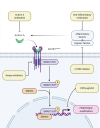Monitoring and Management of Fibrodysplasia Ossificans Progressiva: Current Perspectives
- PMID: 35480068
- PMCID: PMC9035442
- DOI: 10.2147/ORR.S337491
Monitoring and Management of Fibrodysplasia Ossificans Progressiva: Current Perspectives
Erratum in
-
Erratum: Monitoring and Management of Fibrodysplasia Ossificans Progressiva: Current Perspectives [Corrigendum].Orthop Res Rev. 2022 May 4;14:147-148. doi: 10.2147/ORR.S373122. eCollection 2022. Orthop Res Rev. 2022. PMID: 35547785 Free PMC article.
Abstract
Fibrodysplasia ossificans progressiva (FOP), sometimes known as myositis ossificans progressiva, is an ultra-rare disease in which bone is formed in muscular tissue, tendons and ligaments. This is known as heterotopic ossification (HO). FOP is caused by a heterozygous mutation in the highly conserved ACVR1/ALK2 gene which affects about 1 in 1.5-2 million individuals. At birth, patients with the predominant R206H mutation only exhibit a bilateral hallux valgus. During childhood, heterotopic bone formation develops in a typical pattern, affecting the axial muscles first before appendicular body parts are involved. HO can start spontaneously but is often elicited by soft tissue trauma or medical procedures. After soft tissue injury, an inflammatory process called a flare-up can start, followed by the formation of HO. HO leads to a limited range of motion, culminating in complete ankylosis of nearly all joints. As a result of HO surrounding the thorax, patients often suffer from thoracic insufficiency syndrome (TIS). TIS is the most common cause of a limited life expectancy for FOP patients, with a median life expectancy of 56 years. Management is focused on preventing soft-tissue injury that can provoke flare-ups. This includes prevention of iatrogenic damage by biopsies, intramuscular injections and surgery. Anti-inflammatory medication is often started when a flare-up occurs but has a poor basis of evidence. Several forms of potential treatment for FOP are being researched in clinical trials. Progression of the disease is monitored using CT and 18F-NaF PET/CT combined with functional assessments. Patients are regularly evaluated for frequently occurring complications such as restrictive lung disease. Here, we review the current management, monitoring and treatment of FOP.
Keywords: activin A receptor type 1; fibrodysplasia ossificans progressiva; heterotopic ossification; treatment strategies.
© 2022 Smilde et al.
Conflict of interest statement
The authors report no conflicts of interest in this work.
Figures



Similar articles
-
Characterization of flare-ups and impact of garetosmab in adults with fibrodysplasia ossificans progressiva: a post hoc analysis of the randomized, double-blind, placebo-controlled LUMINA-1 trial.J Bone Miner Res. 2024 Sep 26;39(10):1486-1492. doi: 10.1093/jbmr/zjae140. J Bone Miner Res. 2024. PMID: 39216107 Free PMC article. Clinical Trial.
-
Depletion of Mast Cells and Macrophages Impairs Heterotopic Ossification in an Acvr1R206H Mouse Model of Fibrodysplasia Ossificans Progressiva.J Bone Miner Res. 2018 Feb;33(2):269-282. doi: 10.1002/jbmr.3304. Epub 2018 Jan 3. J Bone Miner Res. 2018. PMID: 28986986 Free PMC article.
-
Fibrodysplasia ossificans progressiva: clinical and genetic aspects.Orphanet J Rare Dis. 2011 Dec 1;6:80. doi: 10.1186/1750-1172-6-80. Orphanet J Rare Dis. 2011. PMID: 22133093 Free PMC article. Review.
-
Radiotherapy in Fibrodysplasia Ossificans Progressiva: A Case Report and Systematic Review of the Literature.Front Endocrinol (Lausanne). 2020 Feb 12;11:6. doi: 10.3389/fendo.2020.00006. eCollection 2020. Front Endocrinol (Lausanne). 2020. PMID: 32117050 Free PMC article.
-
[Recommendations for the healthcare of patients with FOP].Orthopadie (Heidelb). 2023 Nov;52(11):924-930. doi: 10.1007/s00132-023-04425-y. Epub 2023 Aug 21. Orthopadie (Heidelb). 2023. PMID: 37603129 Free PMC article. Review. German.
Cited by
-
Structural and molecular imaging-based characterization of soft tissue and vascular calcification in hyperphosphatemic familial tumoral calcinosis.J Bone Miner Res. 2024 Sep 2;39(9):1327-1339. doi: 10.1093/jbmr/zjae115. J Bone Miner Res. 2024. PMID: 39046425
-
The Efficacy of CT Temporal Subtraction Images for Fibrodysplasia Ossificans Progressiva.Tomography. 2023 Apr 3;9(2):768-775. doi: 10.3390/tomography9020062. Tomography. 2023. PMID: 37104133 Free PMC article.
-
[18F]NaF PET/CT as a Marker for Fibrodysplasia Ossificans Progressiva: From Molecular Mechanisms to Clinical Applications in Bone Disorders.Biomolecules. 2024 Oct 10;14(10):1276. doi: 10.3390/biom14101276. Biomolecules. 2024. PMID: 39456213 Free PMC article. Review.
-
Performance of simplified methods for quantification of [18F]NaF uptake in fibrodysplasia ossificans progressiva.Front Nucl Med. 2024 Jul 22;4:1406947. doi: 10.3389/fnume.2024.1406947. eCollection 2024. Front Nucl Med. 2024. PMID: 39381032 Free PMC article.
-
Challenges in the diagnosis of fibrodysplasia ossificans progressiva with the ACVR1 mutation (c.774G > C, p.R258S): a case report and review of literature.Orphanet J Rare Dis. 2024 Sep 30;19(1):360. doi: 10.1186/s13023-024-03363-y. Orphanet J Rare Dis. 2024. PMID: 39350127 Free PMC article. Review.
References
-
- Schroeder HW Jr, Zasloff M. The hand and foot malformations in fibrodysplasia ossificans progressiva. Johns Hopkins Med J. 1980;147(2):73–78. - PubMed
Publication types
LinkOut - more resources
Full Text Sources
Research Materials

